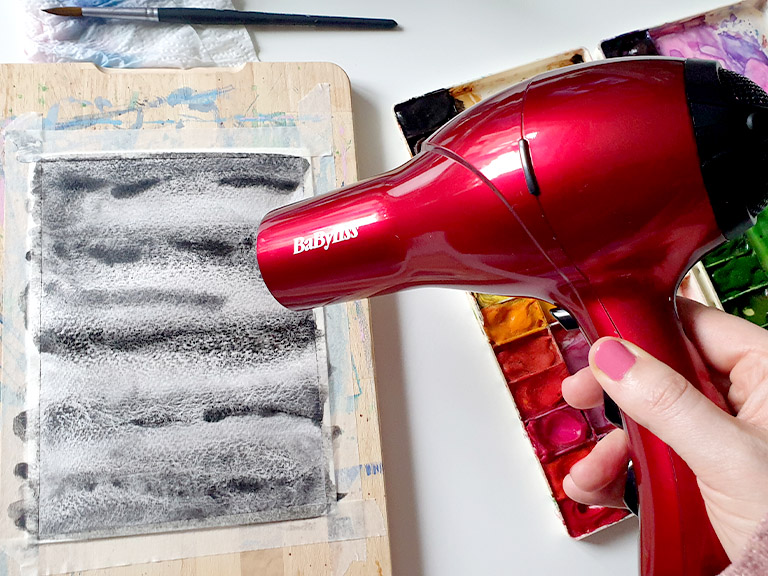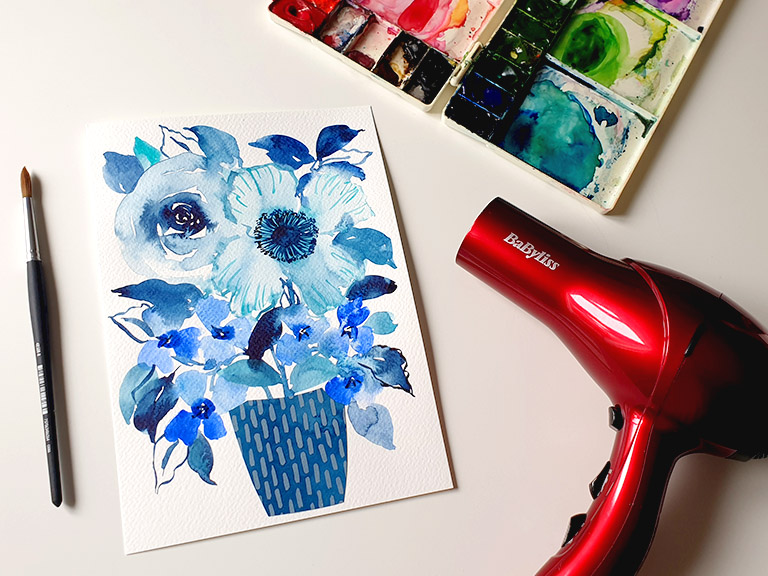Waiting for watercolour to dry is one of the most frustrating parts of the painting process. I am such an impatient person and I just can’t wait for things to dry naturally! But the different layers of colour have to be dry before you keep painting, or everything starts to smudge.
Using a hairdryer to speed up the drying time of watercolour paint can really help out an impatient artist so you can keep working on your piece. But you still need to be careful – holding the dryer too close can splatter the paint or cause the paper to warp. Here’s my handy guide for watercolour beginners.
How long does watercolour paint take to dry?
Watercolour paint typically takes anywhere from a few minutes to half an hour, depending on the thickness of the paint, amount of water content and the ambient temperature and humidity. If the watercolour paper is a high-quality cotton or rough texture, it also takes a lot longer for water to dry.
If your paper isn’t completely dry before you add more layers, the colours could blend and become muddy.

How to use a hairdryer to dry your watercolour painting
Here’s how to use a hairdryer without damaging your painting. Make sure you remove any nozzles before you start.
- Set the hairdryer on low
Use a hair dryer on the lowest heat setting and lowest speed setting, to avoid damaging or warping the paper or causing the paint to crack. Too much airflow may splatter the paint across the paper.
- Hold the hairdryer at a distance
Hold the hair dryer at a safe distance from the paper, around 6-8 inches away, to avoid overheating the paper and causing it to wrinkle or buckle.
- Keep the dryer straight above the paper
Hold the dryer directly above the paper instead of at an angle, to avoid blowing the paint into the wrong area.
- Move the hair dryer constantly
Move the hair dryer back and forth over the paper to distribute the heat evenly and prevent overheating in one spot.
- Keep pausing and checking
As you’re going, keep testing the painting with a fingertip to ensure it’s drying evenly. You’re aiming for dry but not hot!
- Allow the paper to cool
Let the paper cool fully before you add any more paint, or the paint could crack.
- Keep painting
Once the previous layer of paint is dry, you can continue painting and repeating the drying process as needed.
How to tell if your watercolour paint is fully dry
It’s not always easy to tell if your painting is dry, so here are some tests you can try. Keep in mind that even though the surface of the paint may feel dry, the paint may still be slightly damp inside and may take longer to fully dry.
Touch test
You can gently touch the painted area with your fingertip to see if the paint has transferred to your skin.
Tilt the paper towards the light
Look for a dull, matte finish on the painted area, which is a sign that the paint is no longer wet. Any light reflections tell you the surface is still too damp.
Blotting test
You can lightly blot the painted area with a piece of paper or a tissue to see if any colour transfers to the blotter.
Dry brush test
Gently run a dry paintbrush over the painted area, then press it against a paper towel. If the brush doesn’t pick up any paint, then the area is dry.
Now you know how to speed up the drying time, you can create some wonderful paintings with the wet-on-dry watercolour effect!
More watercolour painting guides
Download my free watercolour supply guide
Feeling overwhelmed and confused by watercolour paints, papers and brushes? Download my free guide filled with insider info, including a list of good supplies for every budget, and my complete supply list!
